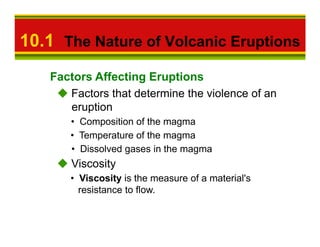
EarthSci 5 - Volcanic Eruptions
- 1. 10.1 The Nature of Volcanic Eruptions Factors Affecting Eruptions Factors that determine the violence of an eruption • Composition of the magma • Temperature of the magma • Dissolved gases in the magma Viscosity • Viscosity is the measure of a material's resistance to flow.
- 2. 10.1 The Nature of Volcanic Eruptions Factors Affecting Eruptions Viscosity • Factors affecting viscosity - Temperature (hotter magmas are less viscous) - Composition (silica content) 1. High silica—high viscosity (e.g., rhyolitic lava) 2. Low silica—more fluid (e.g., basaltic lava)
- 3. 10.1 The Nature of Volcanic Eruptions Factors Affecting Eruptions Dissolved gases • Mainly water vapor and carbon dioxide • Gases expand near the surface • A vent is an opening in the surface of Earth through which molten rock and gases are released. • Provide the force to extrude lava
- 4. 10.1 The Nature of Volcanic Eruptions Factors Affecting Eruptions Dissolved gases • Violence of an eruption is related to how easily gases escape from magma - Gases escape easily from fluid magma. - Viscous magma produces a more violent eruption.
- 6. 10.1 The Nature of Volcanic Eruptions Volcanic Material Lava Flows • Basaltic lavas are more fluid. • Types of lava - Pahoehoe lava (resembles braids in ropes) - Aa lava (rough, jagged blocks) Gases • One to 5 percent of magma by weight • Mainly water vapor and carbon dioxide
- 7. Pahoehoe (Ropy) Lava Flow
- 9. 10.1 The Nature of Volcanic Eruptions Volcanic Material Pyroclastic Materials • Pyroclastic materials is the name given to particles produced in volcanic eruptions. • The fragments ejected during eruptions range in size from very fine duct and volcanic ash (less than 2 millimeters) to pieces that weigh several tons.
- 10. 10.1 The Nature of Volcanic Eruptions Volcanic Material Pyroclastic Materials • Types of pyroclastic material - Ash and dust—fine, glassy fragments - Pumice—frothy, air-filled lava - Lapilli—walnut-sized particles - Cinders—pea-sized particles • Particles larger than lapilli - Blocks—hardened lava - Bombs—ejected as hot lava
- 11. 10.1 The Nature of Volcanic Eruptions Types of Volcanoes The three main volcanic types are shield volcanoes, cinder cones, and composite cones. Anatomy of a Volcano • A volcano is a mountain formed of lava and/or pyroclastic material. • A crater is the depression at the summit of a volcano or that which is produced by a meteorite impact. • A conduit, or pipe, carries gas-rich magma to the surface.
- 12. Anatomy of a “Typical” Volcano
- 13. 10.1 The Nature of Volcanic Eruptions Types of Volcanoes Shield Volcanoes • Shield volcanoes are broad, gently sloping volcanoes built from fluid basaltic lavas. Cinder Cones • Cinder cones are small volcanoes built primarily of pyroclastic material ejected from a single vent. - Steep slope angle - Rather small in size - Frequently occur in groups
- 14. Shield Volcanoes
- 15. Cinder Cones
- 16. 10.1 The Nature of Volcanic Eruptions Types of Volcanoes Composite Cones • Composite cones are volcanoes composed of both lava flows and pyroclastic material. - Most are adjacent to the Pacific Ocean (e.g., Mt. Rainier). - Large size - Interbedded lavas and pyroclastics - Most violent type of activity
- 17. Composite Cones
- 18. Mount St. Helens Before and After the May 18, 1980, Eruption
- 19. Profiles of Volcanic Landforms
- 20. 10.1 The Nature of Volcanic Eruptions Other Volcanic Landforms Calderas • Calderas are large depressions in volcanoes. • Nearly circular • Formed by collapse • Size exceeds one kilometer in diameter
- 21. 10.1 The Nature of Volcanic Eruptions Other Volcanic Landforms Lava Plateaus • Fluid basaltic lava extruded from crustal fractures called fissures.